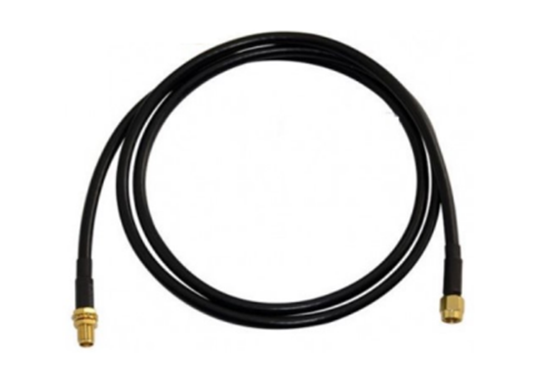
SMA cables
SMA cables are essential components in RF (radio frequency) applications, facilitating efficient signal transmission and maintaining a robust connection between various components. An SMA cable is a coaxial cable fitted with SMA (SubMiniature Version A) connectors, which offer reliable performance and high durability. SMA cables are widely used in telecommunications, Wi-Fi, GPS systems, and many other wireless communication setups.
This article explores SMA cables, their functions, and the significance of SMA to IPEX cables, SMA to UFL cables, and SMA to UFL cable assemblies in modern RF systems.
What is an SMA Cable?
An SMA cable is a coaxial cable equipped with SMA connectors, which are threaded and designed to provide a secure, stable connection. SMA connectors have a compact design that supports high-frequency RF signal transmission, typically up to 18 GHz, and are compatible with various RF devices and systems. The SMA connector’s design features a threaded coupling mechanism that reduces interference, prevents signal leakage, and ensures a reliable connection in both static and dynamic applications.
Structure of an SMA Cable
SMA cables consist of several key components that work together to maintain signal integrity and protect against interference:
- Center Conductor: The core of the SMA cable is made of a conductive material, usually copper or silver-plated copper, which transmits the RF signal.
- Dielectric Insulation: Surrounding the center conductor is a dielectric layer, typically made of PTFE or other insulating materials. This layer helps maintain signal integrity by preventing signal loss.
- Shielding: An outer shield, usually made of braided metal or metal foil, surrounds the dielectric layer. This shield reduces electromagnetic interference, ensuring the RF signal remains clear.
- Outer Jacket: The outer layer of an SMA cable, made of materials such as PVC or Teflon, provides protection against physical damage and environmental factors.
Advantages of SMA Cables in RF Systems
SMA cables offer several benefits in RF systems, making them a preferred choice for various applications:
- High-Frequency Handling: SMA cables can operate at frequencies up to 18 GHz, making them suitable for high-frequency applications like Wi-Fi, GPS, cellular networks, and more.
- Low Signal Loss: The construction of SMA cables, with high-quality materials and a reliable shield, minimizes signal loss, ensuring efficient signal transmission.
- Stable Connection: The threaded SMA connectors provide a secure and stable connection that resists loosening and reduces signal leakage, especially in environments where vibrations or movement may be present.
- Compact Design: SMA connectors are small and lightweight, making them suitable for compact and portable devices where space is limited.
SMA to IPEX Cable: Bridging Compact Devices
An SMA to IPEX cable is a variation of the SMA cable, used to connect devices with an SMA interface to devices with an IPEX (also known as U.FL) connector. The IPEX connector is ultra-compact, commonly used in miniature devices like Wi-Fi modules, GPS antennas, and other wireless communication components.
Applications of SMA to IPEX Cable
- Wi-Fi Modules: Many Wi-Fi modules in compact devices, like IoT devices or embedded systems, use IPEX connectors. An SMA to IPEX cable allows the Wi-Fi module to connect with an external antenna, enhancing wireless range and performance.
- GPS Systems: In GPS modules with IPEX connectors, an SMA to IPEX cable allows for seamless connection with SMA-compatible antennas, improving GPS signal reception and accuracy.
- Drones and Robotics: SMA to IPEX cables are common in drones and robotics, where compact designs require reliable yet miniature connections to avoid adding weight or bulk.
Benefits of SMA to IPEX Cable
SMA to IPEX cables provide the convenience of connecting larger SMA-compatible devices to miniature IPEX-equipped components. This capability makes these cables highly versatile for applications where high-frequency signal transmission must be maintained, even in compact or mobile setups.
SMA to UFL Cable: Flexibility for High-Frequency Connections
Similar to SMA to IPEX cables, SMA to UFL cables bridge SMA-compatible devices with UFL (U.FL) connectors. UFL connectors, commonly found in compact communication modules, offer high-frequency handling and are ideal for applications where space-saving connections are critical.
Key Uses of SMA to UFL Cable
- Embedded Systems: Embedded systems like IoT modules often have UFL connectors, making SMA to UFL cables essential for connecting these systems to larger, more powerful antennas with SMA connectors.
- Wireless Communication Modules: Many wireless modules, like Bluetooth and Wi-Fi, have UFL connectors, requiring SMA to UFL cables for enhanced connectivity to external antennas.
- Portable Devices: Portable devices with space constraints, such as mobile hotspots or navigation systems, utilize SMA to UFL cables to connect with antennas, ensuring reliable signal transmission while maintaining compactness.
Advantages of SMA to UFL Cable
- High-Frequency Support: SMA to UFL cables can handle frequencies up to 6 GHz, supporting most RF applications that rely on compact connectivity.
- Minimal Space Requirements: UFL connectors are ultra-compact, allowing SMA to UFL cables to fit in devices with very limited internal space.
- Easy Installation: These cables are plug-and-play, allowing users to connect or replace antennas easily in various RF devices.
SMA to UFL Cable Assembly: Customized Solutions for RF Applications
An SMA to UFL cable assembly is a customized cable setup that combines SMA and UFL connectors, tailored to specific length, frequency, and power requirements. Cable assemblies are often custom-made to meet the unique specifications of a device or system, ensuring a precise fit and optimal performance in high-frequency applications.
Applications of SMA to UFL Cable Assembly
- IoT and Smart Devices: In IoT systems, SMA to UFL cable assemblies allow for flexible and efficient connections to antennas, improving wireless performance and range.
- Telecommunication Systems: SMA to UFL cable assemblies are widely used in telecommunications to connect base stations, signal amplifiers, and other components that require stable, high-frequency connections.
- 5G and LTE Systems: As 5G and LTE networks expand, SMA to UFL cable assemblies offer the flexibility needed to maintain high signal quality while supporting the higher frequencies these networks use.
Benefits of SMA to UFL Cable Assembly
- Customization: SMA to UFL cable assemblies can be designed with precise specifications, ensuring compatibility and optimal performance for specific RF applications.
- Reliable Signal Transmission: Custom assemblies allow for high-quality materials and designs that reduce signal loss and improve transmission, even in high-frequency applications.
- Space Optimization: SMA to UFL cable assemblies provide effective connectivity in compact devices, where limited space and high-performance connectivity are essential.
Factors to Consider When Choosing an SMA Cable
Selecting the right SMA cable or SMA to UFL/IPEX cable assembly for your application requires considering several factors:
Frequency Range
SMA cables can handle a wide range of frequencies, but choosing one that meets your specific frequency requirements is essential. For example, SMA cables for high-frequency applications, like 5G or advanced Wi-Fi, should have minimal signal loss at those frequencies.
Connector Type
The connector type should match the requirements of the device or system. For compact devices, SMA to IPEX or SMA to UFL cables are ideal as they provide a secure connection while maintaining space efficiency.
Cable Length and Attenuation
The length of the cable directly affects signal loss. For applications that require longer cables, look for low-loss SMA cables designed to minimize attenuation.
Environmental Durability
If the SMA cable is used in outdoor or harsh environments, select a cable with a durable outer jacket to withstand moisture, temperature changes, and UV exposure.
Conclusion
SMA cables, along with SMA to IPEX cables, SMA to UFL cables, and SMA to UFL cable assemblies, offer effective solutions for connecting RF components in diverse applications. Whether for wireless communication, GPS systems, or IoT devices, these cables provide reliable, high-frequency connections while minimizing signal loss. The flexibility of SMA cables makes them indispensable in modern RF systems, ensuring stable connectivity in compact, high-performance, and space-efficient designs. For engineers and technicians, understanding the variety of SMA cable options allows for better decisions and optimal performance in any RF setup.







